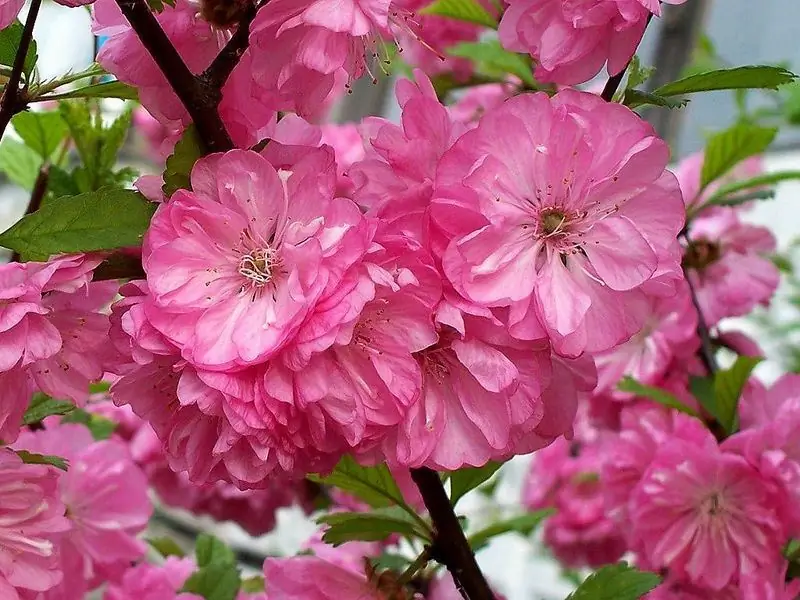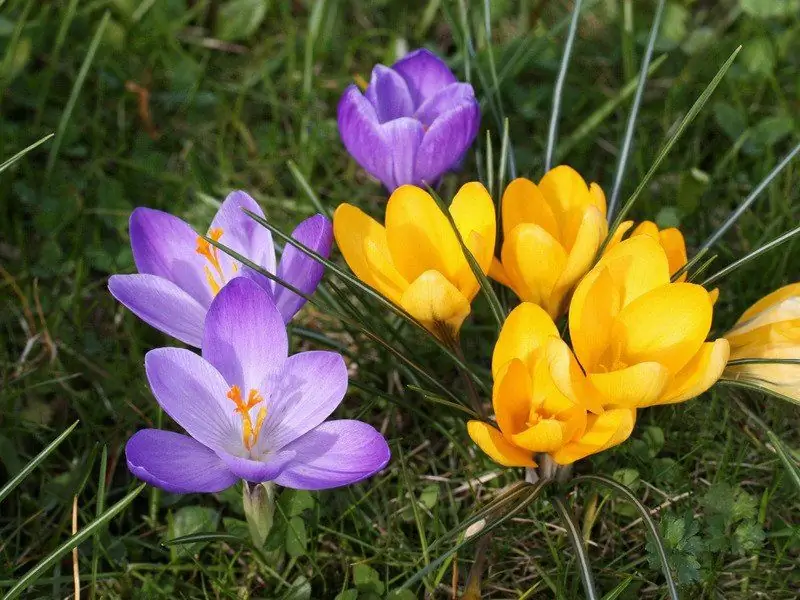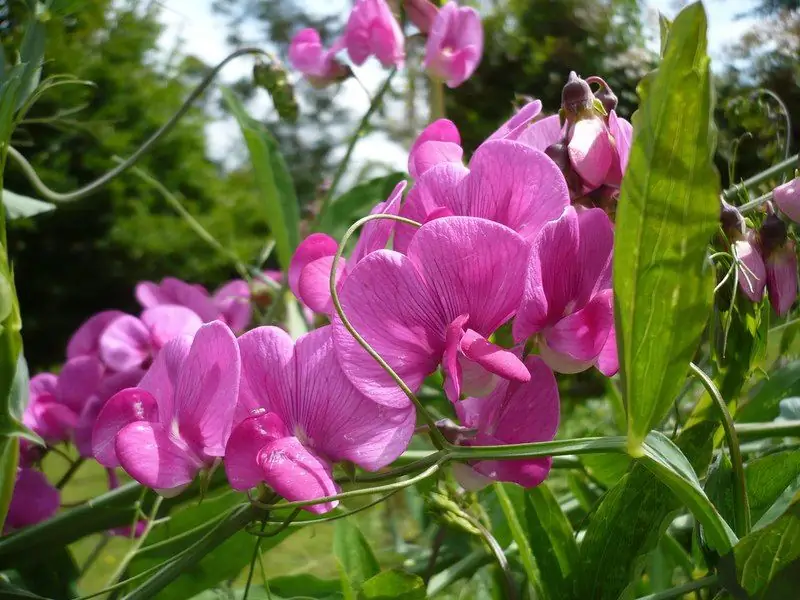
Table of contents:
- Author Bailey Albertson [email protected].
- Public 2023-12-17 12:53.
- Last modified 2025-06-01 07:32.
A selection of ornamental shrubs blooming in spring

Spring is the time of flowering for many ornamental garden shrubs. Some of them bloom very early, as soon as the snow melts, long before the leaves bloom. Other species bloom later, closer to early summer.
Content
-
1 Ornamental shrubs in the garden: the best species blooming in spring
- 1.1 Daphne (wolf, daphne)
- 1.2 Forcing
- 1.3 Henomeles (Japanese quince)
- 1.4 Low almond (steppe almond, bean)
- 1.5 Luiseania (three-lobed almond)
- 1.6 Japanese Kerria
- 1.7 Rhododendrons
- 1.8 Spireas
- 1.9 Lilac
Ornamental shrubs in the garden: the best species blooming in spring
Many ornamental shrubs are unpretentious and grow well in almost all conditions. But there are also more capricious plants among them that need special care.
Wolfberry (wolf, daphne)
Wolves are low shrubs with small pink flowers and narrow leathery leaves located at the top of the branches. Winter-hardy deciduous species are suitable for our gardens:
-
Common wolf (wolf bast) reaches 1-1.5 m in height, is found in the forests of the northern and central regions of the European part of Russia, in Siberia and the Caucasus. Blooms very early, in April - early May, immediately after the snow melts. Blooms for 2-3 weeks, leaves bloom during flowering. Grows well in fertile peaty soil.

Common wolfberry Daffodil blooms very early in spring
-
The upland wolf (Daphne Julia) up to 0.5 m high grows on calcareous soils in Ukraine and the southwestern regions of Russia. Blooms in May - June after the unfolding of leaves.

Boar wolfberry Borovoy wolfberry blooms in late spring - early summer
Volcheberry are moisture-loving, can grow in partial shade, and do not tolerate transplantation.
Forsythia
Forsythia is a heat-loving deciduous shrub up to 2-3 m high with small yellow flowers, native to Europe and China. In the southern regions it blooms very effectively and profusely for 3-4 weeks in March-April before the leaves begin to bloom. In the middle lane it needs shelter for the winter, blooms in April - May. Photophilous, relatively resistant to drought, requires fertile calcareous soil.
In Kazan, forsythia blooms in May simultaneously with the opening of the leaves. Flower buds located above the snow level freeze out almost every year; uncovered bushes bloom only near the ground.

Forsythia is an early blooming, showy shrub with yellow flowers
Henomeles (Japanese quince)
Chaenomeles is a thorny deciduous shrub from Japan and China with red or white flowers 3-5 cm in diameter and small oval leaves. It requires a sunny place and fertile soil, in drought it needs watering.
In the middle lane, in the Urals and Siberia, only Japanese chaenomeles is quite winter-hardy, growing no higher than 1 m and blooming at the end of May after the leaves have completely bloomed
Japanese chaenomeles is often grown here in Tatarstan under the name Japanese quince. It blooms in our area every year, successfully overwinters under the snow without additional protection.

Japanese chaenomeles is a hardy, low-growing shrub known as Japanese quince
In the south, less frost-resistant chaenomeles fine, up to 2-3 m high, is often planted, blooming in March-April and opening the foliage during the flowering period.

Chaenomeles beautiful grows well only in the southern regions
Low almond (steppe almond, bean)
Steppe almond is a low-growing deciduous shrub 1-1.5 m high, growing in the hilly steppes of southern Siberia, the Volga region, Ciscaucasia, Crimea and Ukraine. Leaves are narrow, up to 7 cm long and up to 2 cm wide. It blooms with bright pink flowers up to 2.5 cm in diameter simultaneously with the blooming of the leaves. Duration of flowering 1-2 weeks. In the south it blooms in April, in the middle lane in May. The fruits are not used for food.
Low almonds are very light-requiring, frost-hardy and drought-resistant. It can grow on poor rocky slopes, does not tolerate dampness and acidic soils. Hibernates without shelter.
In Tatarstan, steppe almonds grow in the wild and bloom in mid-May almost every year, sometimes found in gardens.

Low-growing steppe almond - the most winter hardy of all types of almonds
Luiseania (three-bladed almond)
Three-lobed almonds are a large deciduous shrub or a small branchy tree up to 3-4 m high from China and Primorye. It differs from other types of almonds in serrated three-lobed leaves up to 6 cm long. It blooms for 2-3 weeks in April-May with pink flowers 2-4 cm in diameter. It blooms simultaneously with the beginning of leaf opening. In culture, mainly terry form is grown. The fruits are not edible.
Luiseania is frost and drought resistant, but suffers greatly from winter thaws. In a continental climate it can withstand frosts up to -30..- 35 ° C without damage. Photophilous, needs fertile soil with the addition of lime.

Three-lobed almond with double flowers looks especially impressive
Kerria Japanese
Kerria is a deciduous shrub from Japan and China, reaching 3 m in height. Leaves are light green, serrated, up to 10 cm long. It blooms with yellow flowers 3-5 cm in diameter after the leaves open. In the south it blooms in April, in the middle lane - in the second half of May. Duration of flowering is about 1 month. In the southern regions, re-flowering is possible in autumn. Terry kerrias are most often grown in gardens.
Kerria is a heat-loving southern plant. In the middle lane, it needs winter shelter, without which it regularly freezes above the snow level, and in frosty winters the entire aboveground part freezes out. Kerria is photophilous, but in the southern regions it tolerates light partial shade. Requires fertile soil and regular watering.

The most popular of the Japanese kerriya is the terry variety.
Rhododendrons
Rhododendrons are very beautiful but capricious shrubs requiring acidic peaty soils (pH 4.5-5.5) with good drainage, a light or slightly shaded location, and regular watering with soft acidified water. Duration of flowering is about 1 month. The most frost-hardy and hardy deciduous species:
-
Daurian rhododendron (Siberian wild rosemary) 0.5-2 m high. Grows in Siberia and the Far East. It blooms in April - May with pink fragrant flowers up to 4 cm in diameter, appearing before the leaves.

Daurian rhododendron Daurian rhododendron is a very hardy species with early flowering
-
Rhododendron yellow 1-3 m high. Grows in Ukraine and the Caucasus. It blooms in May - June with fragrant yellow flowers up to 6 cm in diameter, blooming simultaneously with the leaves.

Rhododendron yellow Yellow rhododendron is a winter-hardy species that blooms in late spring - early summer
Spireas
Spireas are deciduous shrubs up to 2.5 m high. They are found in the temperate zone of Eurasia and North America. Flowers are small, collected in racemose or corymbose inflorescences. In spring, spireas with white flowers bloom, of which the most popular are winter-hardy:
-
spirea Wangutta up to 2 m high with triple-toothed leaves and corymbose inflorescences;

Spirea Wangutta Spirea Vangutta - bush up to 2 m high with corymbose inflorescences
-
ash spirea up to 2 m high with narrow leaves and flowers completely covering the branches;

Spirea ashy In spirea ash flowers are located along the entire length of the branches
-
spirea crenate no more than 1 m high with small leaves and corymbose inflorescences.

Spirea crenate Spirea crenate grows no higher than 1 meter
Spireas are very unpretentious, do without watering, grow on any soil, except for swampy, tolerate light partial shade, but bloom more abundantly in sunny places. In the middle lane they bloom in May, in the south in April. Duration of flowering is up to 2-3 weeks.
Lilac
Common lilac comes from the Balkan Peninsula. It is a large deciduous shrub or multi-stemmed tree up to 4-7 m in height with heart-shaped leaves that bloom before flowering. In the middle lane blooms for 2-3 weeks at the end of May, in the south - at the end of April. Collected in lush racemose inflorescences, small flowers are lilac or white, very fragrant, simple or double.
Lilac is photophilous, frost-resistant to -40 ° C, drought-resistant, does not tolerate stagnant water, needs lime soil, is durable and does not require special care.
In my garden near Kazan, 5 varieties of lilacs planted by my grandmother in the 70s and 90s of the last century still bloom annually and profusely.

Lilac is one of the most popular and unpretentious spring flowering shrubs
Among the ornamental shrubs of spring flowering, there are both winter-hardy hardy species that easily withstand Siberian frosts, and heat-loving southern plants for a mild climate. When choosing plants for a garden, one must always take into account their winter hardiness and other requirements for growing conditions in order to avoid mistakes and disappointments.
Recommended:
Wild Forest Cat: Photos, Species And Names, Nature And Lifestyle, Breeding Cats

External features of a wild forest cat. The distribution area of the animal. The nature and habits of the predator. Reproduction issues. Wild forest cat in captivity. Reviews
"Pro Plan" Food For Cats And Kittens, Sterilized Animals: Overview, Composition, Range, Pros And Cons, Reviews Of Veterinarians

Is the Proplan food useful for cats? Does it suit all pets? What is included in the feed
Spring Bulb Flowers: Photos And Names

A selection of popular types of winter-hardy and unpretentious bulbous perennials blooming in spring: photos, brief descriptions, the main features of care
Unpretentious Annual Flowers For A Summer Residence: Names And Photos, Including Blooming All Summer

A selection with photos and short descriptions of beautiful and unpretentious annual flowers for novice florists
Shrubs That Grow Well In The Shade

Beautiful and unpretentious shrubs that can be planted in a shaded area and not worry about them
